Why you can trust Tom's Hardware
Our standard benchmarks and power tests are performed using the CPU’s stock frequencies (including stock Thermal Velocity Boost), with all power-saving features enabled. Optimized defaults are set in the BIOS and the memory set using the XMP profiles. For this baseline testing, Windows is set to High Performance before switching over to Balanced during power testing, so the PC idles appropriately.
Synthetic Benchmarks
Synthetics are a great tool to determine if a board runs out of spec, as identical settings should produce similar performance results. Advanced memory timings are the one place where motherboard makers can still optimize for either stability or performance, though, and those settings can impact some testing.



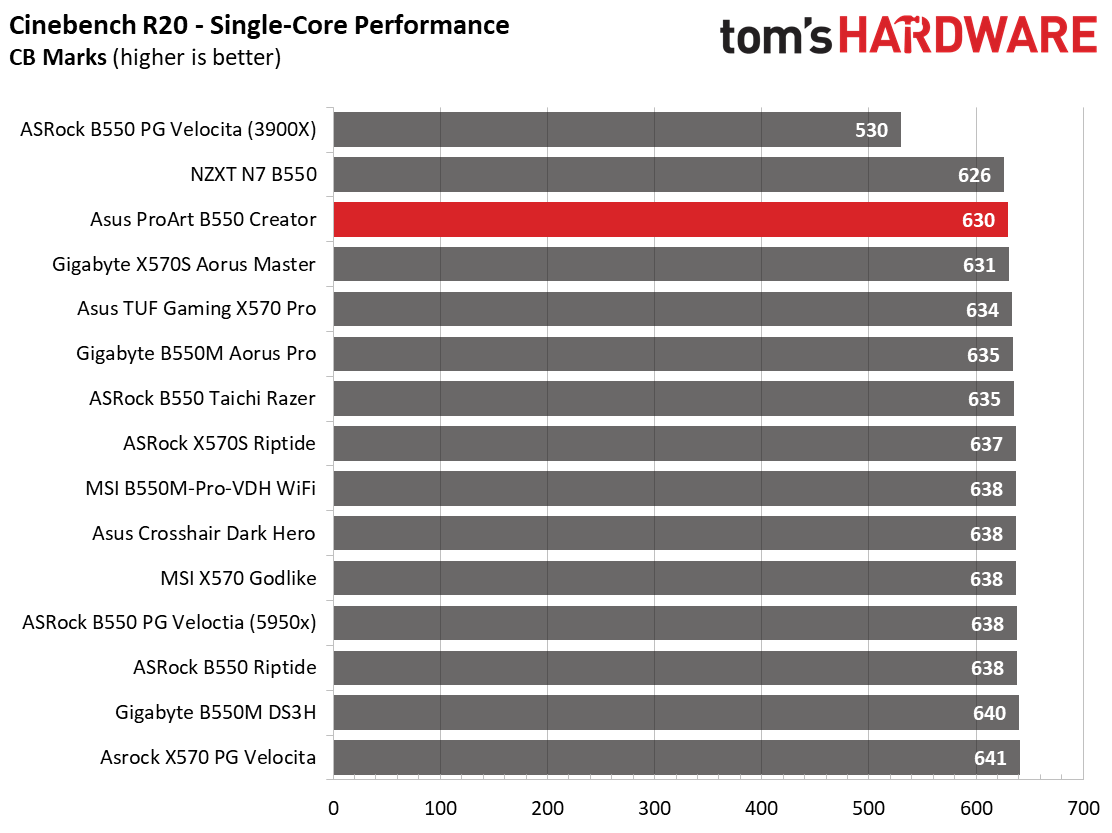








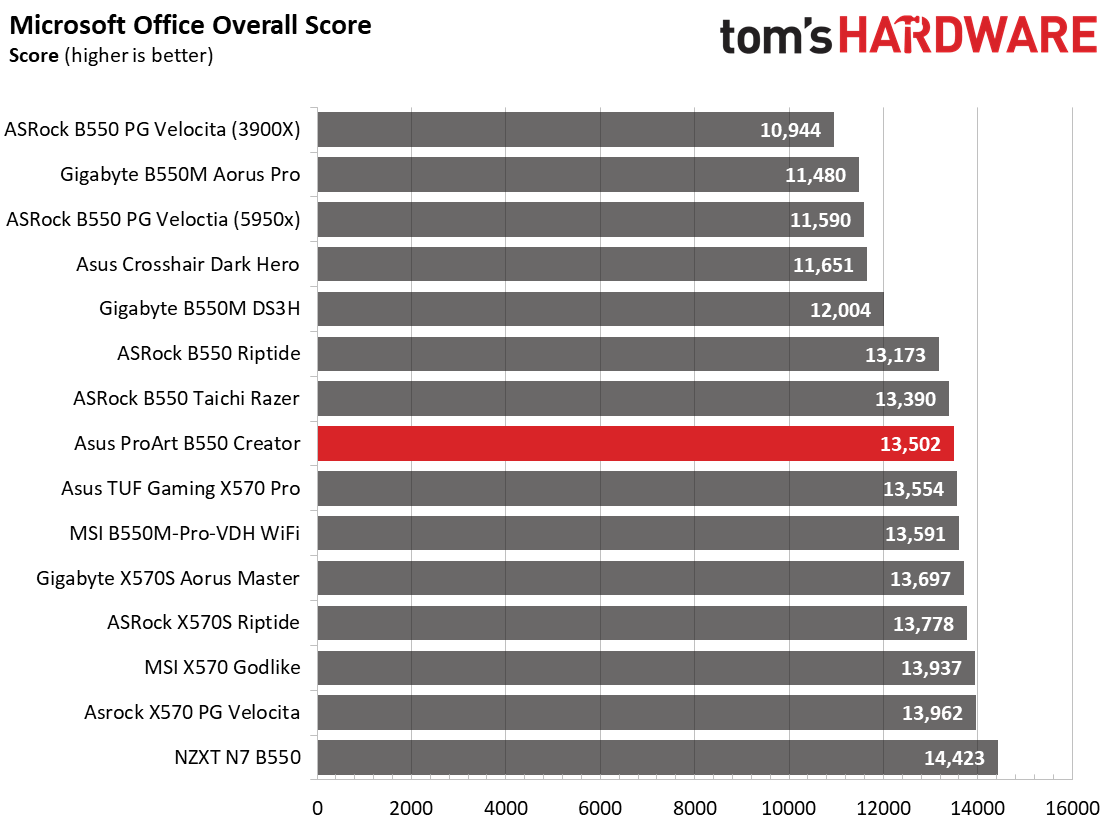




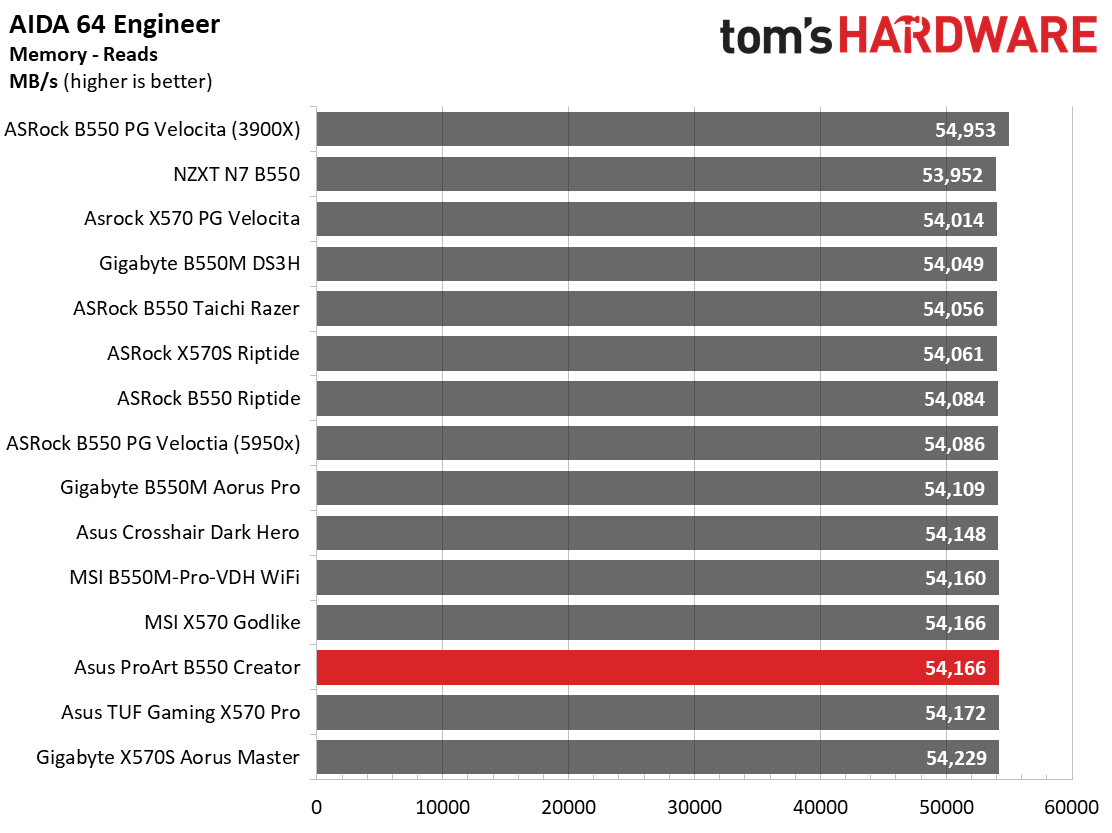



In our synthetic benchmarks, the B550 Creator performed slower than average in POV-Ray (multi) and Cinebench. Sustained clocks were a bit lower than some of the more performance-oriented boards. 7-Zip was the fastest we tested so far in compression, but was one of the slowest in decompression tests. PCMark 10 results in the Office portion were all over the place. Overall, the board is effectively average here, but some tests ran slow, others fast. AIDA memory results were fast in reads and writes, but slower in copy and latency. I was surprised to see slower latency, considering the board runs our memory at a 1:1 ratio by default.
Timed Applications
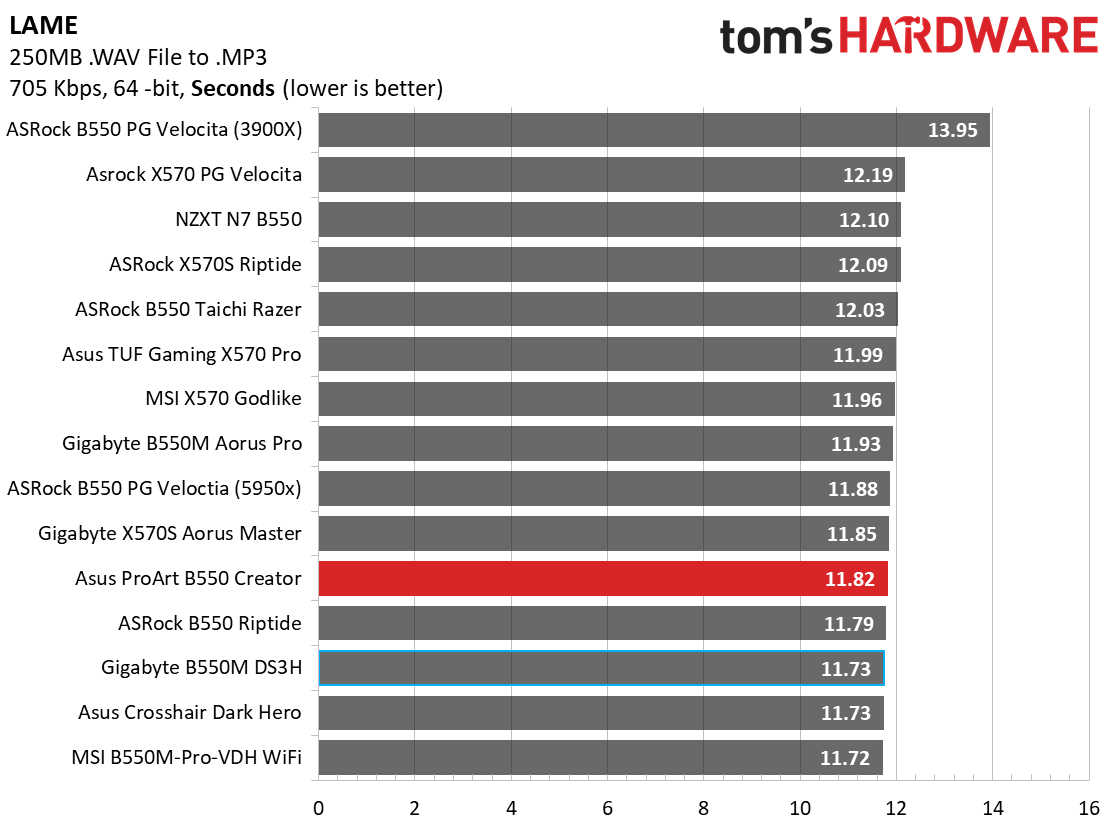



In our LAME testing, the B550 Creator delivered one of the faster results, posting a time of 11.82 seconds (average is 11.91). Corona testing resulted in a time of 48 seconds, which is 2 seconds slower than average (around a 4% difference). Lastly, in our Handbrake testing, the x264 results were close to average (about 1.5% slower) at 132 seconds. The x265 test ran in 309 seconds, which is within the run variance of average (306 seconds, or less than 1%). None of the results here stuck out as being too different than the rest, but the board’s performance does tend to hit the average or negligibly slower.
3D Games and 3DMark



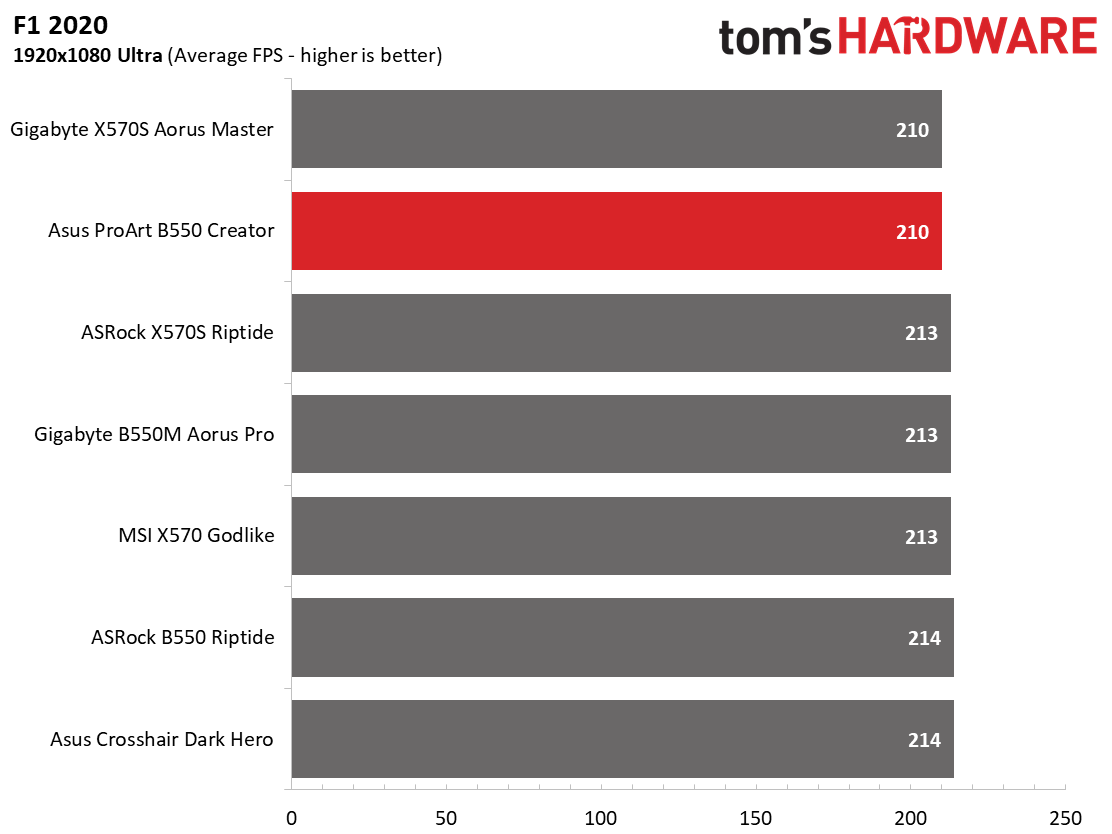
Starting with the launch of the X570S chipset, we’ve updated our game tests and hardware (video card) to match the Intel platform. We stopped using The Division 2 and Forza Horizon 4 and now use Far Cry: New Dawn and F1 2020, running on the Asus TUF Gaming RTX 3070. The games are run at 1920x1080 resolution using the Ultra preset. As the resolution goes up, the CPU tends to have less of an impact. The goal with these settings is to determine if there are differences in performance at the most commonly used resolution with settings most people use or at least strive for. So far, the difference between boards in these tests is slight, with most falling within the margin of error differences.
In F1 2020, the B550 Creator averaged 210 Frames Per Second (more than our Rocket Lake-based system, note), which ties the slowest result so far. That said, it’s a mere 2 FPS (about 1%) behind the average - hardly noticeable. In Far Cry, this board averaged 131 FPS, which is a 1 FPS above average. It’s worth noting that, in Far Cry, the Intel-based machines run around 10-15 frames per second (a few percent) faster. Results in both 3DMark tests matched the others. In the end, the B550 Creator did well here.
Power Consumption / VRM Temperatures

We used AIDA64’s System Stability Test with Stress CPU, FPU and Cache enabled for power testing, using the peak power consumption value. The wattage reading is from the wall via a Kill-A-Watt meter to capture the entire ecosystem. The only variable that changes is the motherboard; all other parts are the same.
Get Tom's Hardware's best news and in-depth reviews, straight to your inbox.
At idle, the B550 Creator used 75W, which is again around the average of tested boards so far. Load wattage peaked at 210W, also around the average if not slightly less than most others. We saw the board fluctuate between 3.6 and 4 GHz during testing, which is typical behavior. This averages out to 143W and is overall is a middling result.
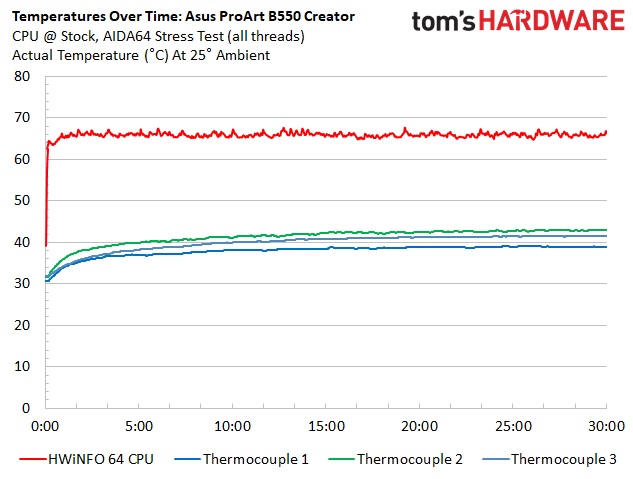
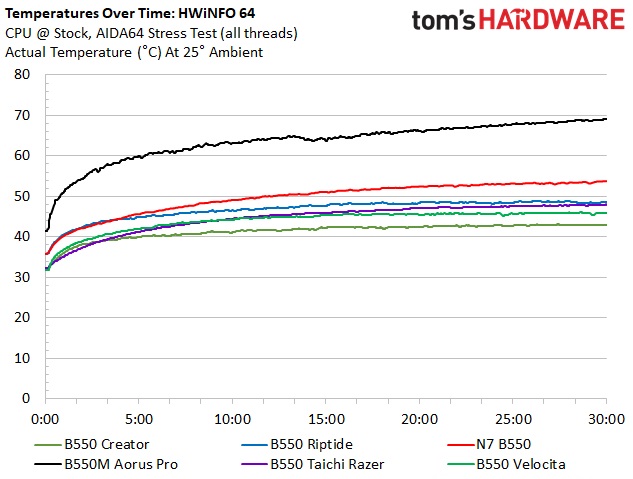
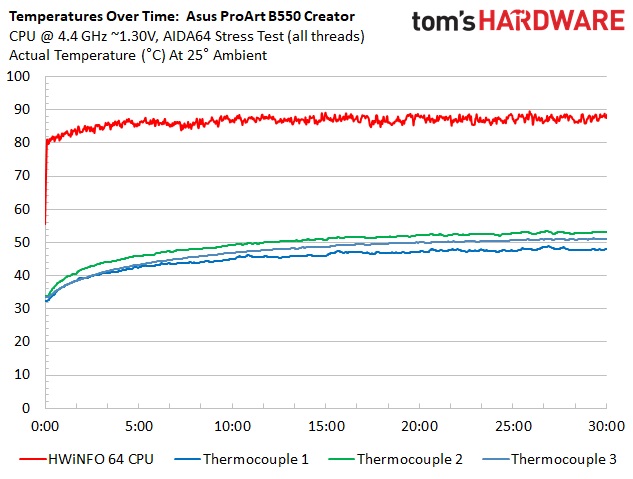

The B550 Creator peaked just under 45 degrees Celsius during stock operation, which is the coolest result we’ve seen on a board with passive heatsinks. When we overclocked to 4.4 GHz, VRM temperatures peaked around 55 degrees Celsius, again one of the cooler temperatures we’ve recorded so far. The oversized heatsinks do a great job keeping things cool even with the CPU pushed to its ambiently cooled limits.
Overclocking
There are several ways to overclock on AMD platforms, depending on your goals. If your focus is single-threaded performance, you may want to focus on using Precision Boost Overdrive (PBO) and adjusting its parameters. If you can use all cores and threads, setting a manual CPU multiplier and voltage is likely the better route. While the latter clips peak single-threaded performance slightly, it increases all core/thread performance over the all-core boost. To that end, we settled on 4.4 GHz at ~1.3V for an all-core/thread overclock.
The B550 Creator has no issues with our 16-core/32-thread Ryzen 9 5950X. We simply plugged in 1.3V, adjusted LLC to all but eliminate vdroop, and trudged through the test. It’s worth noting that CPUz didn’t read the Vcore right, nor did Hwinfo, so it’s tough to know exactly how much voltage the CPU was running with.
On the memory side, we know AMD is limited to around 3600/3733 MHz when keeping FCLK at a 1:1 ratio with the memory. With this in mind, we add two more sticks and run 4x8GB at DDR4 3600, which is AMD’s current sweet spot. For our B550 Creator, we were able to set XMP, and it was stable enough to run through several of our benchmarks. As always, your mileage may vary depending on the memory kit used and the quality of the integrated memory controller.
Final Thoughts
Asus’ B550 Creator hit the scene focusing on content creators and bringing along two Thunderbolt 4 Type-C ports, dual 2.5 GbE, dual M.2 sockets, capable power delivery, and more. Priced at $299.99, the board sits squarely in the high-end of B550 boards (although mid-range overall). It’s a well-rounded solution that performed well in our gaming tests and the more generic tests such as PCMark 10. Performance in some tests was a bit off the average, but in most, you’d be hard-pressed to see the difference outside of benchmarks.
I would like to see an additional M.2 socket on the board, as content creators tend to use a lot of space (depending on the task, of course) and need fast storage. Your most basic budget B550 boards include two, so this is lacking comparatively. Along those lines, the B550 Creator only has four SATA ports. This was done to minimize lane sharing among the PCIe slots and such, but it’s worth noting if you need to use more than four SATA drives. Last, for the money, I would also like to see integrated Wi-Fi. In the end, these aren’t deal-breakers, but if you wish to have more M.2 and SATA storage, you’ll have to move up to X570-based boards with the additional PCIe lane flexibility (and cost).
As far as competition goes, there is only one comparable board running the B550 chipset: the Gigabyte B550 Vision D-P, which also happens to be priced the same at $299.99. Between them, I like the look of the Vision D-P a bit better, but that is entirely subjective. Specs and features-wise, these boards are remarkably similar. Both sport two M.2 sockets and four SATA ports, but the Gigabyte board includes Wi-fi 6 (though it only has one 2.5 GbE port). The most significant difference is Thunderbolt connectivity, with the B550 Creator using Thunderbolt 4 while the Vision uses TB3. You can connect two 4K displays (or one 8K) with TB4, where TB3 maxes out at 4K. Between them, it’s a toss-up depending on your needs. While there are other boards around that price point with more M.2 storage and integrated Wi-Fi, they aren’t made for content creators. You lose the Thunderbolt ports and the additional display flexibility (among other things) that come with them.
If you’re in the market for an AMD Ryzen-based system and planning to use it for content creation and productivity, the Asus ProArt B550 Creator is a viable option around the $300 price point. You get Thunderbolt 4 connectivity, Dual 2.5 GbE, and those ingenious latches for M.2 modules. Overall, we like what this board has to offer for content creators and their workflows. If your work fits within the confines of the B550 chipset and its limited storage flexibility, the B550 Creator is a solid board to build your AMD system around.
MORE: Best Motherboards
MORE: How To Choose A Motherboard
MORE: All Motherboard Content

Joe Shields is a staff writer at Tom’s Hardware. He reviews motherboards and PC components.
-
HideOut dual thunderbolt is NOT worth $125. You can find boards with one 2.5g and more sata and such WITH 12xx autio for $150 all day. If you want more LAN bandwidth you can get all that + 10gb ethernet for alot less too, and get more M2 ports and sata ports. This board makes no sense to me.Reply
Here is a very overpriced add-in card you can use for dual Tbolt 4, even from Asus. https://www.newegg.com/asus-90mc09p0-m0aay0-pci-express-to-thunderbolt/p/N82E16815293048?Description=thunderbolt&cm_re=thunderbolt-_-15-293-048-_-Product&quicklink=true -
tek-check I own this motherboard for 4 months now and it works pretty reliably so far. There is no good reason to complain about not having third M.2 slot, as B550 platform has set amount of available PCIe lanes. Besides, one can always purchase higher capacity NVMe storage to meet their needs on two slots. Simple. Less e-waste and plastic for packaging.Reply
Designers of the board maxed out on connectivity, working with what is available. Well done to them. Two TB4 ports use x4 PCIe 3.0 lanes and bring more versatility than having another M.2 slot. Super fast external storage can be attached at any time, such as TB3 NAS/DAS, plus display, plus TB docking station, plus 10 GbE networking, etc. Plenty of options. How much more one could possibly want with B550?
For those who stubbornly desire third M.2 slot, this board is flexible enough in configuration and you have additional two options: use x4 PCIe 3.0 slot on the chipset for expansion card with NVMe drive (this turns off TB4) or use x8 PCIe 4.0 second GPU slot to attach two NVMe 4.0 drives. Suddenly, you can have 3 NVMe 4.0 drives and 1 NVMe 3.0. Not enough? Leaving GPU to operate in the first x8 PCIe 4.0 slot will be just fine. GPUs still cannot saturate fully x16 PCIe 3.0 bandwidth, so it will work fine in x8 PCIe 4.0 slot with the same bandwidth as x16 PCIe 3.0. Testing GPUs in x8 PCIe 4.0 vs. x16 PCIe 4.0 slot showed negligible difference. Higly recommended motherboard. -
Spanky Deluxe I've been using this board for a couple of months now and it's been great. The only issue I had was that screen sharing in Discord would cause all my USB ports to stop working - an issue with the B550 chipset that AMD had fixed via microcode for BIOS updates quite a while ago but for some reason the BIOS that ASUS sold the boards with (which came out after the AMD fixes) did not have the relevant microcode fixes. ASUS did finally release a BIOS update last month that let me fix the issue though.Reply
This board made complete sense to me as the add-in Thunderbolt cards are reportedly a bit flakey whereas the Thunderbolt support on this board is supposed to be rock solid. I don't currently use the Thunderbolt functionality but I'm going to be reconfiguring my home office within the next six months or so and I'm likely going to go hide the computer away in a hidden storage area at the other end of my office and so like the idea of using a Corning optical thunderbolt cable connected to a dock to connect my main devices. I just wanted that future proof functionality. -
tek-check Reply
I'd kindly request from Joe Shields to communicate to Asus and challenge them on the marketing claim that this motherboard hosts "HDMI 2.1" port on the back panel. They say, quote: "HDMI 2.1 (4K60)". "4K/60" is vague enough to be considered a feature specific to HDMI 2.1 spec.Admin said:The Asus ProArt B550 Creator offers dual Thunderbolt 4 Type-C and 2.5 GbE ports, along with a mid-range $299.99 price. If you can work with limited speedy internal storage, this is a solid option. Otherwise, the X570 platform may be a better choice due to the additional PCIe lanes/storage flexibility.
Asus ProArt B550 Creator Review: Designed for Pros, Works for Joes : Read more
4K/60 10/12-bit RGB image would qualify as HDMI 2.1 feature, becasue it requires more than 18 Gbps of bandwidth for transport and this can only be done with new FRL protocol introduced by HDMI 2.1 spec
4K/60 8-bit RGB can work over older TMDS protocol, which is standard HDMI 2.0b
So, not all "4K/60" signals are the same and can be delivered both by older TMDS protocol and newer FRL, depending on bit depth and required bandwidth.
I have challenged them twice via email and they have never answered my questions as regards to which specific features from HDMI 2.1 spec does this HDMI port support and how those features are anabled. One member of technical support team told me that the port supports older 1.4 spec speeds (10.2 Gbps), which is closer to truth on Vega platform.
There could be only two ways how HDMI 2.1 can work on a motherboard:
1. APU natively outputs FRL faster signal. FRL is core part of HDMI 2.1 spec
No current APU from AMD, including Ryzen 5000G series, support FRL signalling. Those APUs output HDMI signal by using older TMDS pixel clocks by Vega iGPU. By the way, Intel's CPUs neither have this capability.
2. APU is helped by additional level shifter/conversion chip DP 1.4-HDMI 2.1
Close shots of the motherboard in TechPowerUp review do not show that such chip is installed. So, has Asus installed a level shifter/converter HDMI 2.1 chip on this motherboard to enable FRL signals up to 40 or 48 Gbps? Can they answer this question, please?
If the motherboard does not have this enabling chip, Asus must remove "HDMI 2.1 (4K/60)" from marketing, as such claim would be meaningless and misleading the public. Whoever has this motherboard, please challenge them to provide with the evidence that this port can operate FRL protocol and deliver images with bandwidth above 18 Gbps. -
tek-check Reply
It is, so far. I run a display from one TB4 port, via DP-in from GPU, and use another port for various things, most recently for 10 GbE networking between two PCs at home.Spanky Deluxe said:Thunderbolt support on this board is supposed to be rock solid
The only thing people need to be aware of is that TB does not deliver FreeSync or VRR feature for gaming. Intel was supposed to work to enable this to work like on DisplayPort. -
PEJUman Reply
I have used TB3 AIC in the past, they all require a special connector (not sure for what) into a TB3 header in the motherboard.HideOut said:dual thunderbolt is NOT worth $125. You can find boards with one 2.5g and more sata and such WITH 12xx autio for $150 all day. If you want more LAN bandwidth you can get all that + 10gb ethernet for alot less too, and get more M2 ports and sata ports. This board makes no sense to me.
Here is a very overpriced add-in card you can use for dual Tbolt 4, even from Asus. https://www.newegg.com/asus-90mc09p0-m0aay0-pci-express-to-thunderbolt/p/N82E16815293048?Description=thunderbolt&cm_re=thunderbolt-_-15-293-048-_-Product&quicklink=true
This TB4 card also shows that cable still being used + "*Intel only 500 series MB compatibility..."
I wish I can just add this TB4 AIC card to any PCI-E 3.0 4x slot, but I am not 100% sure it'll work flawlessly without that special header connected. Which is my guess on why this B550 board is priced as a niche TB4 solution for AMD. -
tek-check Reply
It's not going to work properly.PEJUman said:I am not 100% sure it'll work flawlessly without that special header connected.
Because it is a niche. It's the first ever, and the only one at the moment, TB4 solution for AMD platfom. Latest, fastest connectivity solutions for Ryzen 5000, without all that heat and power consumption from Core CPUs. A breath of fresh air in motherboard line-up. My PC runs silently, even with heavier workloads on many cores.PEJUman said:Which is my guess on why this B550 board is priced as a niche TB4 solution for AMD.
Besides, many consumer electronics products are a bit pricier due to Covid disruption. There have been factories around the world closed for months and sourcing components has offen been a nightmare, let alone complications with shipping. Got this board on the first day when it arrived to local PC shop and never looked back. -
excalibur1814 "creators, that also works well for more general users"Reply
Years back you could just buy any motherboard/cpu, then get creating or gaming depending on your GPU. Those were simple days. Now you have to check if the board you're buying is a 'creator' model, a standard board, or both. I mean, it's just crazy now. Anyone would think that any board will allow you to do anything, realistically. Creator or standard!
/s -
deesider Reply
I like that idea too. It's just taken a long while for the available technology to make it possible without too many compromises.Spanky Deluxe said:This board made complete sense to me as the add-in Thunderbolt cards are reportedly a bit flakey whereas the Thunderbolt support on this board is supposed to be rock solid. I don't currently use the Thunderbolt functionality but I'm going to be reconfiguring my home office within the next six months or so and I'm likely going to go hide the computer away in a hidden storage area at the other end of my office and so like the idea of using a Corning optical thunderbolt cable connected to a dock to connect my main devices. I just wanted that future proof functionality.
